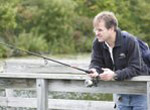
Leave No Trace … Lead Included

Ben Montgomery and Cathy Malok from Raptor Trust last winter retrieved “Brooke,” an injured bald eagle that was found near a water treatment plant in Short Hills, N.J.
Updated April 30, 2010.
If you're going fishing, do wildlife a favor and replace your lead sinkers with something less toxic such as tin, bismuth, steel, and tungsten-nickel alloy. And if you shoot guns, consider getting rid of your lead ammunition and think about copper or copper-tin composite bullets.
You may want to do these things to protect yourself, too, because small, leaded fishing tackle has been banned in Maine, New York, and Vermont. Other states also have restrictions, depending on tackle size and fishing location; the U.S. Fish & Wildlife Service prohibits the use of lead sinkers at Yellowstone.
Part of the problem is that loons can't distinguish the difference between rocks and lost lead weights on the lake bottom (check this link to test your mettle). Bald eagles and California condors aren't that discerning when they feed on the remains of a deer that might have been shot but not bagged. The U.S. Geological Survey says these birds can die from the ingestion of one lead shot, bullet fragment, or sinker.
But at least one of them didn't.
Last winter, New Jersey American Water reported that two employees of the Canoe Brook Water Treatment Plant in Short Hills, N.J., found an injured bald eagle while performing maintenance near a marshy area on Reservoir Road. The bird, a juvenile female, was unable to fly. The company's Environmental Manager Gary Matthews called The Raptor Trust, which sent a team to help capture the bird. The team named her "Brooke" after Canoe Brook.
She worked her way to a patch of grass several yards out into a marshy area—ranging in depth from 6 inches to 5 feet—that was beginning to ice over. Using two shallow water kayaks to approach the bird, Cathy Malok and Ben Montgomery jumped out of the kayaks and entered the icy water to rescue the bird. Brooke was transported to The Raptor Trust facility in Millington, N.J., for examination.
Blood tests revealed that the eagle was suffering from lead poisoning, three times the normal level in her system. The Raptor Trust treated her with two rounds of chelation therapy to bind and remove the lead from her body, and her lead levels returned to normal.
Lauren Butcher, education director at The Raptor Trust, said that Brooke made a full recovery, regaining her appetite and flying ability. Thanks to quick thinking by American Water and a facility like The Raptor Trust, the eagle was released where rescuers originally found her about a month after her Dec. 17 capture.
It's too late to recover all the lost lead sinkers and spent shot from the environment, but maybe we don't have to add to the problem. Think about it.
Bald eagles are no longer endangered but they are protected by the Migratory Bird Treaty Act and the Bald and Golden Eagle Protection Act. The yellow-billed loon should be listed as threatened or endangered, but alas, other species have higher priority, which has downgraded the loon to "candidate species" (March 2009). The California condor is endangered and lead ingestion has been cited as one of several factors in its decline.
Posted by L.K. Williams, EPonline on Apr 26, 2010